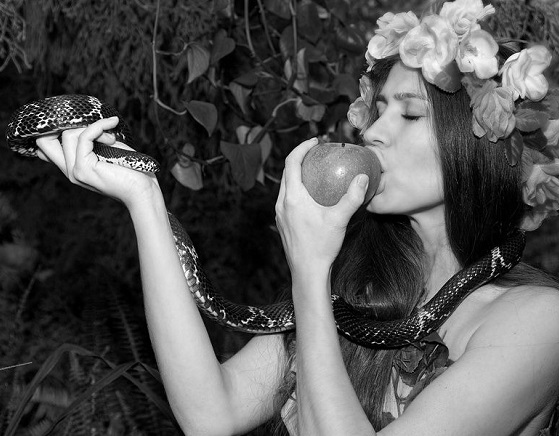The Tree of life and the Serpent: What the Ancient Goddesses Came to Teach Us.

{source}
Anyone who was brought up on Western religious traditions knows the story of Adam and Eve, the Tree of Knowledge, the Tree of life and the Serpent.
It is a strange, foreboding story that ends with the expulsion of humanity from Paradise for disobedience. This story has never made any sense to me. In my book The Jerusalem Diary, I voiced this suspicion but did not explore it. I just sensed something fishy there and left it at that. But I have spent the last few months exploring alternative explanations of the story with some interesting results, to say the least.
But first things first.
What is fishy about the story?
Firstly, Eve, the female protagonist, is either stupid or bad. Having studied Biblical stories, I have found women are nearly always the bad guys, with very few exceptions.
Secondly, I have always had an issue with following unreasonable orders such as ‘Don’t eat from the Tree of Knowledge’ (Genesis 2-3). Well, my friends, I love knowledge, and will certainly eat of that tree as much as I wish and as much I can. That’s the tree I am interested in. So let’s get the record straight right here!
Thirdly, the story as it is passed to us in its current form makes no sense whatsoever. Why would an all-loving God behave badly and not want us to know the most essential part of our story? And, worse, punish us for wanting to know? That’s bad parenting, to say the least.
So I have moved on to studying some Jewish Kabbalistic explanations I have found touching and more reasonable. I have found some wisdom there and a genuine desire to understand the true meaning of the story. I was almost convinced.
For example, the fall from grace represents the fall into the ego, while the Serpent represents duality. By listening to the Serpent, both Adam and Eve were punished for the consequence of their actions (disobedience).
But then, almost by chance, I recalled the pre-Christian goddesses of Sumer, Babylon and Egypt; they are all major deities represented with the Tree of life and the Serpent in a very positive context! So I looked into these stories closer.
First of all, the stories of such goddesses are much older than the Biblical stories. According to the most conservative mainstream archaeologists, the culture of Sumer is at least 7000 years old. Thus — let me stress this — the stories of the goddesses, the Tree of life and the Serpent are older than the Biblical stories.
Secondly, each of the goddesses represented with the Tree of life and the Serpent tells an uplifting and empowering story of humanity and not a story of punishment.
So now let’s look at some of these goddesses, even if very briefly.
The first goddess we know of from Sumer represented with the Tree of life and the Serpent is Ninmah. She sits on the throne as the main deity, with the raised upward Serpent behind her and the Tree of life in front of her. With her hand extended, she offers the Fruit of Life (resurrection or life eternal) to the male figure sitting on the other side of the Tree of life (possibly her male consort).
Similarly, the goddess Inanna (also known as Ishtar in Assyria) is portrayed dancing with the snakes and the Tree of life, and is said to represent the axis between the matter and spirit. Scholars such as Van Dijk and Parpola argue that this represents the ‘celestial pole that connects heaven and earth’ (Betty De Shong Meador, 2000) and can be traced to early Mesopotamia (and the goddesses).
Interestingly, Inanna is also now very explicitly connected to the story of resurrection. She descends to the Underworld, but returns resurrected and sacrifices her male consort Dumuzid as a price for her resurrection, although she manages to resurrect him also for six months a year to be with her.
Another familiar story (but a watered-down version) associated with resurrection is that of betrayal. Dumuzid assumes Inanna’s power when he is in the Underworld, which might be a reason she later sacrifices him for six months.
Now let’s move on to ancient Egypt and the almighty goddess Isis. Here the stories of the Serpent, the Tree of life, betrayal and resurrection reach their dramatic climax.
Isis is represented with an Ankh — the Egyptian symbol of immortality which, in my opinion, is the combination of the Tree of life and the Serpent, with the Serpent coiling on the top creating the Tree. Isis’ husband Osiris is killed by his brother Seth (the betrayal) but Isis manages to temporarily resurrect Osiris and conceive a child (Horus) with him.
Does this sound familiar?
In all the instances, each goddess is called the Queen of Heaven, a title later given to the Virgin Mary. In each instance, the goddess is responsible for the Tree of life and the Serpent, and the closer we get to Biblical times, the story of betrayal becomes more and more prominent until we reach Mary Magdalene, where the story gets reversed.
In the story of Mary Magdalene, the goddess is demeaned as a prostitute, without any scriptural evidence, and although she is not responsible any more for the resurrection of the young god, she is still somehow necessary, as it is she who sees him resurrected and breaks the news to the male disciples who scattered in fear of prosecution!
The closer we get to Biblical times, the more demeaned goddesses are, and I would argue that perhaps the betrayal here is not on the goddess but on all of us. Someone has been rewriting the ancient story for reasons unknown to us.
The story of betrayal, for example, is very strong in Gnostic stories of creation where some malevolent forces (the archons) interfere in the process of creation and separate us from our Source and the true knowledge (gnosis) of who we are.
Let’s look at imagery. What are alternative explanations for the Tree of life and the Serpent?
I have found two explanations especially compelling. The Tree of life represents the meeting of spirit and matter, represents the possibility of life eternal (resurrection) and perhaps hidden knowledge of this. The goddess is the benevolent power that wants to share this gift or knowledge with humanity (us), since her hand is extended towards us.
The Serpent, especially in its outstretched, vertical position, could represent an awakened kundalini energy which Hindu tradition claims is in our unawakened divine potential.
Other alternative theories promote the possibility that the Serpent represents our DNA helix. Interestingly, the majority of our DNA is called junk DNA by scientists, which means they have no idea why it is there.
Imagine if we activated this dormant, junk DNA. We would be the beautiful beings that we were meant to be. We would what the yogic scriptures call us to be: “You are That!”
And I suspect this is exactly what the ancient goddesses came to teach us.
The question, however, remains, who were these goddesses? I have some theories here. Personally, I do not believe that they were some random goddesses as there are too many similarities there.
My first and favorite proposition is that it is one and the same goddess which resurrects herself in our consciousness (or what Carl Jung would call collective unconscious) to remind us of our own potential and possibility.
The second and bolder one is that some interdimensional, highly evolved beings — be it angels, be it avatars, depending on the tradition — reincarnate themselves every once in a while with the same purpose: asking us to awaken from the slavery of the mundane and reach for our spiritual evolution.
The choice is yours, and I would love to know your take on it.
***
Dr. Joanna Kujawa is the author of ‘Journaling to Manifest the Lost Goddess in Your Life’ and ‘Jerusalem Diary: Searching for the Tomb and House of Jesus’, and many short stories, essays and academic pieces. She sees herself as a Spiritual Detective who asks difficult questions about spirituality, such as ‘Can spirituality and sexuality be experienced as one?’, ‘Who was the real Mary Magdalene?’, ‘How can we include eco-spirituality in our belief systems?’ and ‘How can we bring back the Divine Feminine to create a more balanced and interconnected world?’ Her goal is to create and participate in the shift in consciousness about spirituality, our connection to nature, and our place in the Universe. She has PhD from Monash University, and MA and BA from the University of Toronto. She is immoderately passionate about her Goddess News blog. You could connect with her via her website, Facebook, Twitter or YouTube.
***
{Join us on Facebook, Twitter, Instagram & Pinterest}

